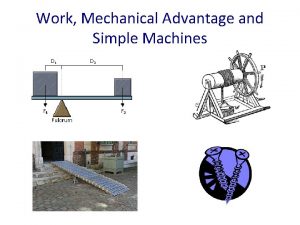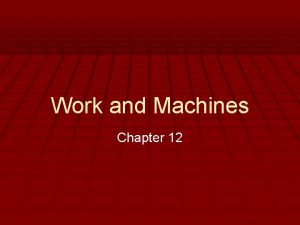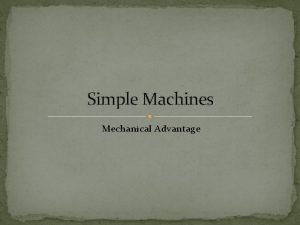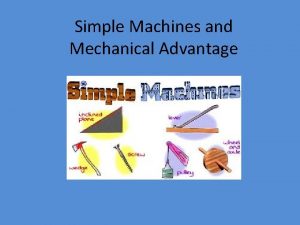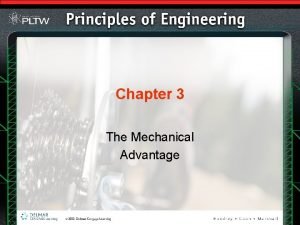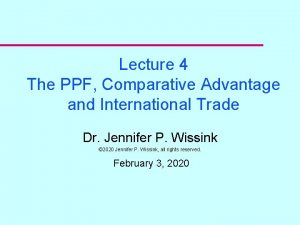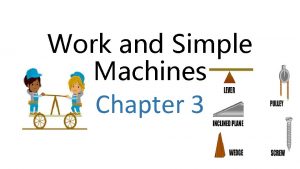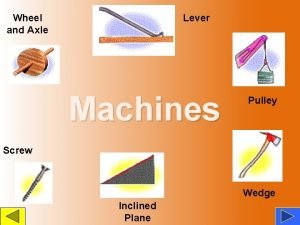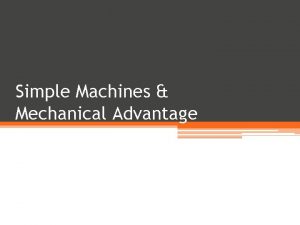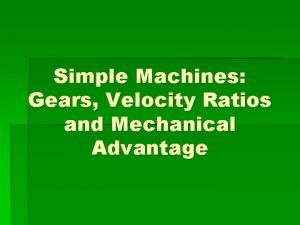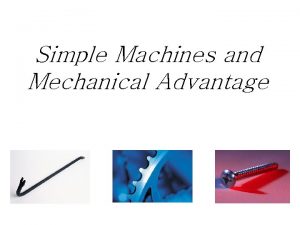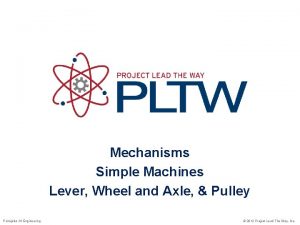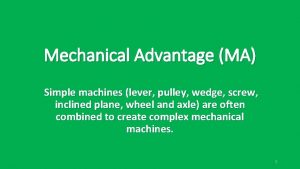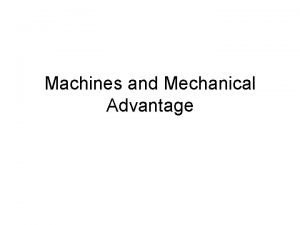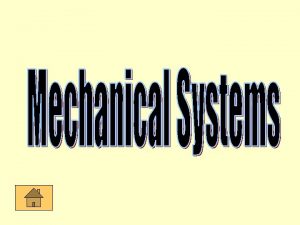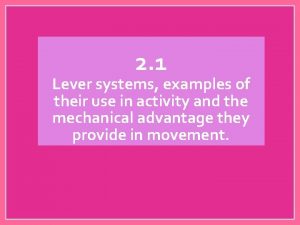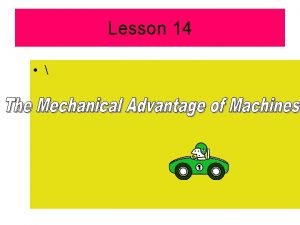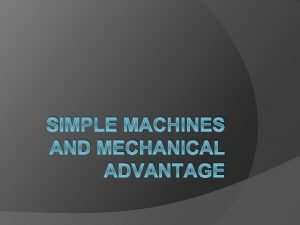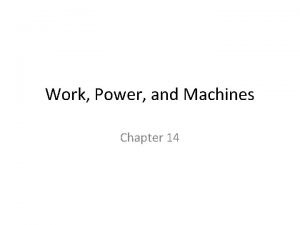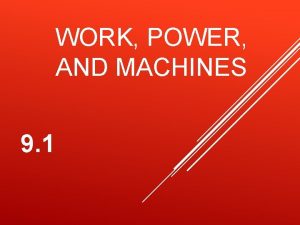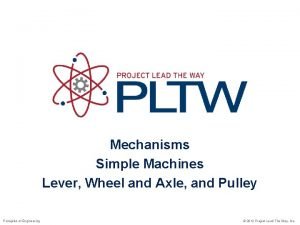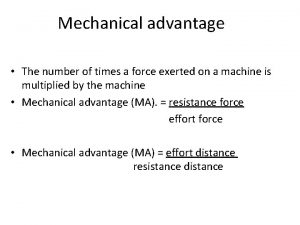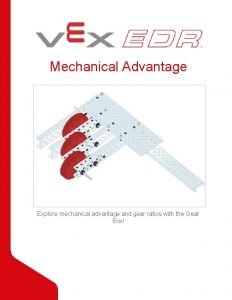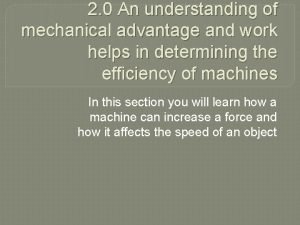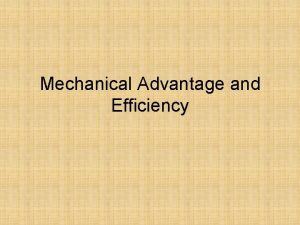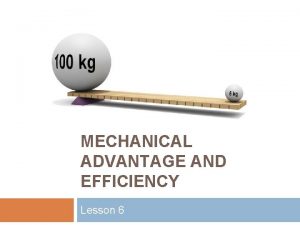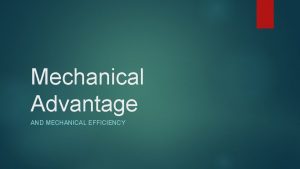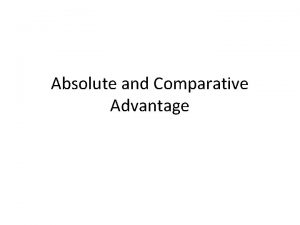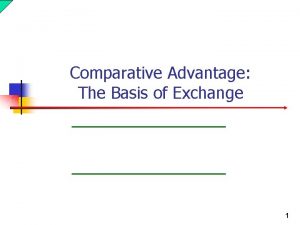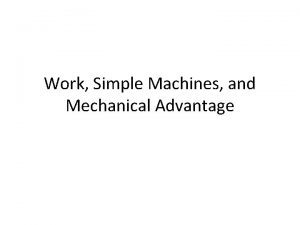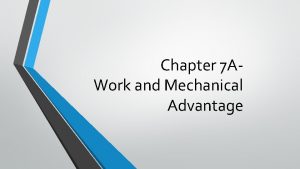Work Mechanical Advantage Mechanical Work the exchange of





































- Slides: 37

Work & Mechanical Advantage

Mechanical Work • the exchange of energy for some change in a physical system • symbolized by W and measured in joules

Mechanical Work • W = Fd • F is the force applied to the system parallel to the system’s displacement, in Newtons

Mechanical Work • W = Fd • d is the displacement of the system, in meters

Mechanical Work • a scalar quantity • can be positive, negative, or zero (ex. in your text)

Mechanical Work There are three conditions for work to occur: 1. A force must be applied. 2. The object must move. 3. The force must be applied in the direction of motion.

Mechanical Work When work is done on a system it gains energy.

Sample Problem 1 Take a force of 100 N (about 22 pounds) and use it to move an object 7 m. How much work has been done? W = Fd W = (100 N)(7 m) W = 700 N • m = 700 J

Sample Problem 2 If a 157 N force is applied to an object, and this force causes the object to move 3. 89247 m, how much work has been done? W = Fd W = (157 N)(3. 89247 m) W = 611. 11779 N • m = 611 J

Power is the rate of doing work. It is how fast the energy is released. work power = time The unit of power is the watt.

Power A machine doing more work in the same time or the same work in less time than another machine, means it has more power.

Power work power = time work = force • distance

Sample Problem 3 If you weigh 550 N and run to the top of a skyscraper (300 m) in 1650 seconds, what would the power usage be? W (550 N) • (300 m) Power = = ΔT 1650 s = 100 watts

Simple Machines • Simple machines can help do work faster and easier. • They help reduce the toil of work caused by the curse on fallen man. • They do not change the amount of work necessary to do the job.

Simple Machines Simple machines can be classified as: • levers • wheels and axles • inclined planes


http: //www. angelfire. com/mb 2/mbench/ch 7/ Pictures/wheel_axle_examples. gif


Efficiency • Theoretically, a machine can be no more than 100% efficient. • Practically, a machine must be less than 100% efficient. • Efficiency is expressed as a percentage using the formula: Wout × 100 Win

Sample Problem 4 If a fan receives 352 J of electrical energy and produces 328 J of mechanical energy, what is its efficiency? (3 SDs) Wout 328 J × 100 = 93. 1818% × 100 = 352 J Win = 93. 2% efficient

Distance Principle

Distance Principle If W stays the same and F decreases, what must happen to d?

Distance Principle So the force is reduced by exerting that force over a longer distance.

Mechanical Advantage (MA) • The reduction in force is called the Mechanical Advantage (MA). • There are two types of Mechanical Advantages: 1. Actual MA (AMA) 2. Ideal MA (IMA)

Mechanical Advantage (MA) • One way to calculate the AMA is: weight resistance Fr = = force effort Fe

Mechanical Advantage (MA) • In this example the force exerted, the effort, is 550 N. • The weight or resistance is 3, 300 N.

Mechanical Advantage (MA) resistance 3300 N AMA = =6 550 effort N • MA has no units. • Force is multiplied 6 times by exerting that force over 6 times the distance.

Mechanical Advantage (MA) • The AMA shows the helpfulness or usefulness of the machine. • The AMA includes the effects of friction. • We will often assume there is no friction. Then we can compute the IMA. • The AMA is always less than the IMA.

Mechanical Advantage (MA) • IMA is determined just from the dimensions of the simple machine.

Mechanical Advantage (MA) • Another way to compute the IMA of a simple machine is to divide the displacement of the effort by the displacement of the resistance. IMA = d effort = 12 m d resistance 2 m IMA = 6

T/F If you push against an object, but it does not move, work was done. F Question

What is the formula for work? 1. 2. 3. 4. W=f • d W=f/d W=f+d W=f−d Question

What work is done when a force of 500 N moves an object 7. 00 m? 1. 2. 3. 4. 507 N • m 71. 4 N • m 3500 N • m 493 N • m Question

What is the SI unit of work? 1. 2. 3. 4. N • m J Volt Watt Question

Why use a machine? 1. 2. 3. 4. It makes less work. It changes the direction. It uses less force. It uses more mass. Question

How much power is generated if 2500 joules of work are done in 10 seconds? 1. 2. 3. 4. 2, 490 watts 25, 000 watts 2, 510 watts Question

What is the SI unit of power? 1. 2. 3. 4. N • m J Volt Watt Question
 Actual mechanical advantage vs ideal mechanical advantage
Actual mechanical advantage vs ideal mechanical advantage How does mechanical advantage work
How does mechanical advantage work The force you exert on a machine
The force you exert on a machine The ratio of resistance force to effort force
The ratio of resistance force to effort force Wheel and axle mechanical advantage
Wheel and axle mechanical advantage Ideal mechanical advantage definition
Ideal mechanical advantage definition Ppf
Ppf Real exchange rate vs nominal exchange rate
Real exchange rate vs nominal exchange rate Pearl exchange activity
Pearl exchange activity Gas exchange key events in gas exchange
Gas exchange key events in gas exchange How do you calculate mechanical advantage
How do you calculate mechanical advantage Pulley ama formula
Pulley ama formula Ma 6
Ma 6 Gear velocity ratio
Gear velocity ratio Mechanical advantage
Mechanical advantage Wheel and axle pulleys and gears
Wheel and axle pulleys and gears Efficiency simple machines
Efficiency simple machines Pulley lever wedge
Pulley lever wedge Mechanical advantage
Mechanical advantage Mechanical advantage symbol
Mechanical advantage symbol Formula of potential energy
Formula of potential energy First class lever sporting example
First class lever sporting example Difference between ideal and actual mechanical advantage
Difference between ideal and actual mechanical advantage Actual mechanical advantage definition
Actual mechanical advantage definition Mechanical advantage triangle
Mechanical advantage triangle Mechanical advantage
Mechanical advantage Wheel and axle ima
Wheel and axle ima Formula of effort
Formula of effort Gear ratio mechanical advantage
Gear ratio mechanical advantage Understanding mechanical advantage
Understanding mechanical advantage Hát kết hợp bộ gõ cơ thể
Hát kết hợp bộ gõ cơ thể Lp html
Lp html Bổ thể
Bổ thể Tỉ lệ cơ thể trẻ em
Tỉ lệ cơ thể trẻ em Gấu đi như thế nào
Gấu đi như thế nào Tư thế worm breton
Tư thế worm breton Chúa yêu trần thế alleluia
Chúa yêu trần thế alleluia Các môn thể thao bắt đầu bằng tiếng chạy
Các môn thể thao bắt đầu bằng tiếng chạy

